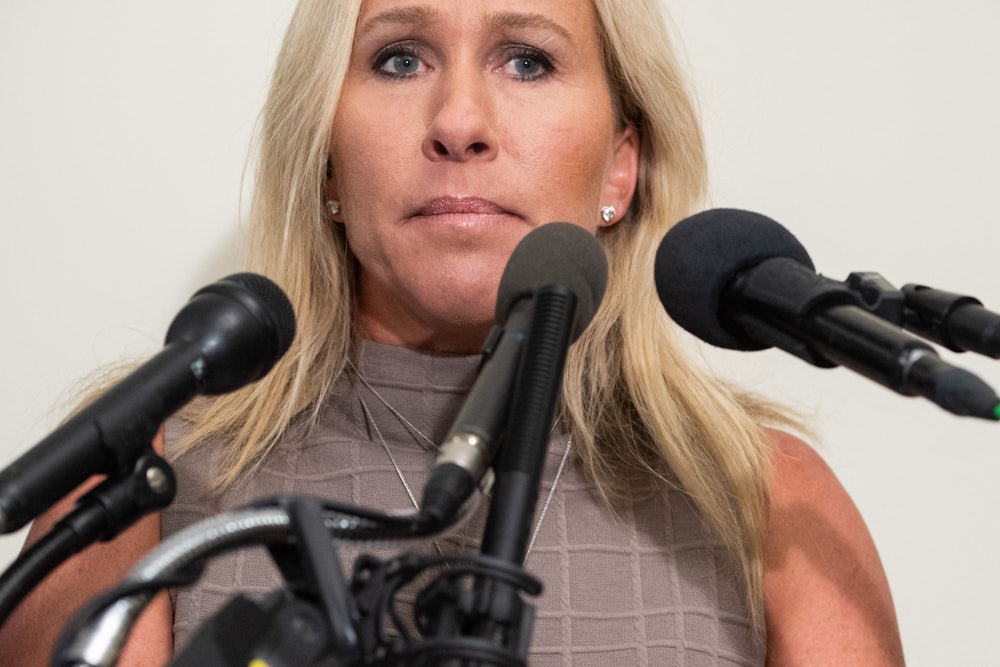The Republican Party’s retreat from meaningful policymaking in recent years hasn’t just ensured that robust and productive debates over governance and ideas have faded from the scene. The vacuum produced by the lack of substantive activity has created opportunities for a new breed of troll lawmaker to fill it with a never-ending display of “own the libs” spectacles. The newly minted members of Congress from the MAGA-QAnon set—Madison Cawthorn, Marjorie Taylor Greene, and Lauren Boebert—have been this movement’s leading lights, and they barely pretend that they have a legitimate role to play as lawmakers. As Defector’s David Roth said of Boebert, who melted down after being asked to comply with a bag check by Capitol Hill security, “This is what she understands the job to be. She’s not there to sit in subcommittee meetings, she’s there to do this shit every day, and also to post.”
In recent weeks, the flamboyant trollery of this gang of extremists reached a new apogee, when Greene and her colleague Paul Gosar attended the America First Political Action Conference, or AFPAC—essentially a white nationalist confab thrown together by Nick Fuentes, who summarized his own politics like so: “All I want is a total Aryan victory. All I want is revenge … I’m just like Hitler.” Greene and Gosar may have brought embarrassment on their party, but Republican leadership struggled to mete out any type of strong punishment.
But there’s some good news on that front: Congress is currently eyeing the passage of a $1.5 trillion omnibus spending package to fund the government. According to Politico’s Jennifer Scholtes and Connor O’Brien, the bill will grow domestic spending by $730 billion, while kicking yet another pile of cash ($782 billion) to the Pentagon. But the most interesting part of the bill isn’t the top lines: It’s the fact that the measure would bring back earmarks “for the first time since Congress banned the practice more than a decade ago.” And that’s very bad news for Boebert, Greene, and the like.
I know that sounds strange: How will bringing earmarks help tamp down these wild and untamed MAGA members of Congress? Well, earmarks will help responsible congresspersons draw a stark contrast with their idiotic colleagues. The primary purpose of a member of Congress is to allocate and spend taxpayer money. Thanks to the formal ban on earmarks, they’ve been doing it with one hand tied behind their back. Moreover, the lack of earmarks has allowed Greene and Boebert to luck into a situation where they can thrive in Congress doing little more than occasional headline-grabbing stunts. But if Congress reverts to its former, earmark-happy self, touching off a hunt for money and perks to bring back home to constituents, then that will require a different skill set for members to succeed—one that I do not believe members like Greene currently possess.
In the interests of full disclosure, back when Congress got rid of earmarks, I was inclined to support it; to my mind it resembled an avenue for graft and was a frequent forum for petty infighting. But in 2014, Erikka Knuti, a former congressional staffer who was then serving as a Democratic strategist for the communications firm Purple Strategies, gave me a solid dressing-down about how and why I was wrong. One huge factor that I had not considered, she told me, was that earmarks were how lawmakers on the losing side of big ideological debates manage to save face. Maybe they lost the big battle to abolish the Export-Import Bank, but as a consolation prize, they brought home a much-needed overpass or hospital wing. They got their constituents something useful, to tide them over as the fight over the bigger battles continued. As Knutti told me, “The average person is going to drive over that overpass more times than they can directly feel the impact of the Export-Import Bank.”
Without earmarks, the only way to demonstrate your commitment to your constituents is through ever-escalating demonstrations of ideological purity, which puts every member of Congress in the very game that Greene and Boebert are already playing to perfection. But if earmarks return, these MAGA wastrels might have to put down their iPhones and start doing some real work—and giving them more real work to do might help keep them out of trouble. After all, should they decide to keep faffing around, their constituents might find out that the member of Congress in the neighboring district brought home that much-needed overpass and start wondering why their own representative in Washington wasn’t putting in a shift getting them some similar perks. From there, their primary and general election opponents will be able to make a strong case that they frittered away their time in office, failing the folks at home.
Right about now you might be wondering, “Can we afford more Bridges to Nowhere in Alaska? In this economy?” But remember: The system worked back then; the Bridge to Nowhere never got built! And as Knutti was keen to remind me, even if it had gotten built, the total cost to taxpayers would have only been $398 million, a relative bargain when you put it up against the billions of dollars lost in the debt-ceiling brinkmanship and government shutdowns that rose once the sweet, sweet legislative grease of earmarks went away. We built a much more expensive bridge to a much worse nowhere, and we’re living there right now.
As The New York Times’ Tom Edsall pointed out seven years ago, extant polling demonstrated the earmark ban didn’t even lessen the cynicism that the public had for Congress, it only increased the intractable gridlock that everyone hates. Knutti told me that this should have been anticipated when Congress decided to ban the practice. “If people start to think, ‘Well, Congress isn’t doing anything for me. Who are they doing stuff for?’ the answer is ‘the other guy.’” This is the central irony of the earmark ban: The well-intended solution to the appearance of corruption only heightened those appearances. “When your congressman comes back to their district with nothing tangible but the promise to fight for this or that, with no results,” Knutti said, “what’s the difference between that and a snake oil salesman?”
According to Politico, the potential return of earmarks is viewed as a vital “sweetener” that is “sure to build support” for the omnibus, “since lawmakers will be able to tout specific projects they got funded in their districts.” Senator Roy Blunt, in fact, says that earmarks have created “a specific micro-reason” to get behind the bill. “It’s easy to be opposed to things on a macro basis,” Blunt told Politico. He added that “member-directed spending allows you to have something you can go home with.”
That basically hits the nail on the head. Bringing earmarks back would be a small but practical measure that could make a meaningful difference in the way Congress works: It could lower the temperature of the big ideological battles, end a few legislative logjams, and get taxpayer dollars out of government coffers where it’s doing no one any good. And if, along the way, it helps members who put a premium on hard work ascend, while shortening the terms of some of these cryptofascist, Twitter clout–chasing clowns, all the better.
This article was adapted from a previous edition of Power Mad, a weekly TNR newsletter authored by deputy editor Jason Linkins. Sign up here.










